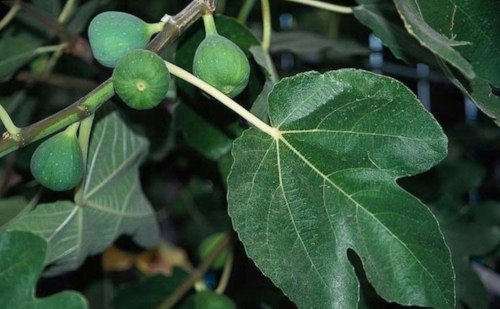Edible Fig (Ficus carica)
Arabic name: تين
The Edible Fig (Ficus carica) with its handsomely lobed leaves and edible fruit is a picturesque tree with a dramatic spreading habit. One of the longest cultivated fruit trees, it is native to Asia Minor, and has been commonly naturalized in the Mediterranean region. It favors rocky places, including old walls, and is long-lived, becoming attractively gnarled in old specimens.
This beautiful deciduous tree adds much to any garden, with its attractive foliage patterns, delicious fruit, and its broad overlapping leaves that provide welcome summer shade. Its fruit has been enjoyed since antiquity, and comes in two crops: the first in midsummer on last year’s wood, the second in early autumn on the current year’s growth. The tree usually starts bearing fruit within two years of planting. It can grow to a height of 8m, with a spread of 8m, and has a moderate growth rate of about 25cm per year.
Requirements:
Grows in full sun, and is drought-tolerant to the point where seedlings grow from stonewalls. It grows best in well-drained soil.
Water usage:
The Edible Fig requires no watering once established. Generally, trees need supplemental irrigation to get established, especially if planted after the rainy season. During the first year, irrigate in the amount of 20 – 25 liters of water twice a week. During its second year, a tree needs to be irrigated in the amount of 40 liters once a week. Beginning with the third year, trees usually get established, and some, like the Edible Fig, do not require any supplemental irrigation.
Appearance:
The Edible Fig has a broadly spreading growth habit when young. Leaves are rounded in outline, reaching 30cm long and across, deeply cut into three to five lobes, heart-shaped at the base, toothed, glossy green above, and rough with hairs on both sides, turning yellow in autumn. Bark is gray and smooth. Both male and female flowers are very small, and are borne inconspicuously inside a fleshy green receptacle, the whole green then ripens to brown or purple, forming the edible fig.
Notes on use:
A fruit-bearing specimen tree; used as a decorative tree in patios, but fruits may drop on pavements; good for rural gardens. Plant where fruit and leaf drop are irrelevant.
Propagation:
Propagates by dormant hardwood cuttings, or by root suckers.
Maintenance:
The Edible Fig is a very undemanding tree. It requires light pruning just to form and open the tree’s branches. It responds well to pruning in the dormant season, for size control and to increase the main crop.
For best fruiting, the tree needs very little fertilizer, as fertilizers promote growth and reduce fruit quality.
Comments:
The leaves and milky sap may cause skin irritation for some people, but they can still enjoy the fruit, which can be eaten fresh or dried. Also, the roots of the Edible Fig tree are invasive.
Image source: http://www.30bananasaday.com
Image source: http://www.mijardin.es
This article is part of a series of articles prepared by the Center for the Study of the Built Environment (CSBE) on water conserving landscapes.
For additional information on water conserving gardens, visit the CSBE web site at www.csbe.org
Support for the CSBE project on water conserving landscapes is provided by WEPIA (Water Efficiency and Public Information for Action), a program being implemented in collaboration with the Ministry of Water and Irrigation and funded by the United States Agency for International Development (USAID).


